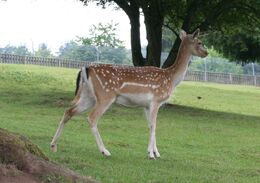
Fallow Deer Buck

Fallow Deer Doe
The Fallow Deer is considered to be medium in size. They have a light brown coat with white spots. They are one of the few species of deer that don’t lose their spots a few months after birth. There are some sub species out there that are actually all white and they have dark eyes. This isn’t due to Albinism though as some people think. They are very rare to find.
The antlers of these deer are very wide and they can easily measure 20 inches in width. It takes about three years for the males to develop them in this size. Full grown males weigh from 130 to 200 pounds. Full grown females weight from 60 to 90 pounds. They are extremely fast animals thanks to their powerful legs. Yet their legs are quite short and that makes for very interesting overall body design.
Distribution
It is easy to see the Fallow Deer as they tend to feed out in the open grassy areas. However, they prefer to have wooded areas around where they can rest and hide from danger. They tend to only live in areas where there is plenty of food in the summer and a decent chance of finding it in the winter months.
Behavior
The Fallow Deer are very social animals, especially with the females. They will form big herds. If food supplies start to become scarce they will split into smaller groups as this will increase their chance of survival. They males are loosely associated with the herds, coming and going. It isn’t until mating season that they really start to keep an eye on the females around them.
Feeding
Green grass is the main food source for the Fallow Deer. They will spend hours grazing and finding the best grasses. They tend to be somewhat picky about what they will consume. They will look for green grass first but if they can’t find it then they will settle for the brown grass. It is believed the green grass is more appealing due to the amount of moisture it contains. They will also strip bark form the trees to consume when their normal eating items are hard to find. They can often be seen eating in the early morning and then again as the sun goes down.
Reproduction
Mating for the Fallow Deer extends from late September until late November. The males will become very aggressive with each other during this period of them. They will section of areas that they will fight for the right to mate in with the females. It is common though for a buck to follow a doe that is ready for mating through various territories, regardless of who he has to battle in order to continue following her.
Even though the males are ready for mating when they are a couple of years old, they average four years of age before they are able to do so. It takes approximately that long for them to develop the antlers to attract females, to fight dominant males with, and to have the courage to fight with other males instead of walking away.
For the females, it isn’t uncommon for them to have their first fawn when they are only about two years of age. The young fawns are born about 240 days after mating takes place. They are born either in May or June of the following year. Twins are quite common for this species of deer but single births are still the highest percentage. They also can live for about 20 years in the wild and 25 when they are raised in captivity.